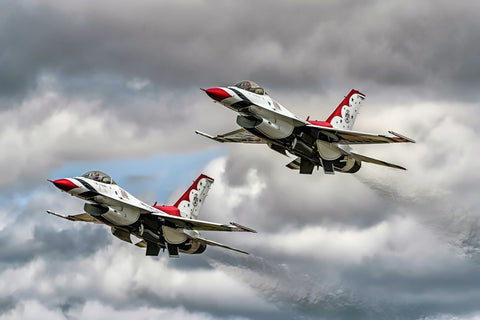The F-16 Fighting Falcon: A Closer Look
The F-16 Fighting Falcon is a single-engine supersonic fighter jet that was developed by General Dynamics (now Lockheed Martin) in the 1970s. The aircraft has since become one of the most widely used combat aircraft in the world, with over 4,600 built and flown by 26 different countries.
In this post we are going to take a closer look at the F-16 and briefly explain why giving them to Ukraine at this moment is a fool's errand.

The F-16 is known for its exceptional maneuverability, which is due in part to its unique "fly-by-wire" flight control system. This system uses electronic signals instead of traditional mechanical linkages to control the aircraft's movements, allowing for greater precision and responsiveness in flight.
The aircraft is also highly versatile, with the ability to perform a wide range of missions, from air-to-air combat to ground attack and reconnaissance. Its armament includes a 20mm cannon and a variety of air-to-air and air-to-ground missiles, bombs, and rockets.

One of the F-16's most distinctive features is its "bubble" canopy, which provides the pilot with excellent visibility and situational awareness. This, combined with the aircraft's agility and speed, makes it a formidable opponent in air-to-air combat.
The F-16 has seen action in numerous conflicts around the world, including the Gulf War, Operation Desert Storm, and Operation Enduring Freedom. It has proven to be a reliable and effective fighter jet, with a combat record that speaks to its capabilities.
In addition to its combat roles, the F-16 has also been used for other missions, such as aerial reconnaissance and scientific research. NASA, for example, has used modified F-16s for various research projects, including testing new aircraft designs and studying atmospheric phenomena.

Despite its age, the F-16 remains a highly capable aircraft that continues to be upgraded and modernized to meet the evolving needs of modern warfare. Its versatility and agility make it a valuable asset to any air force, and its combat record speaks to its effectiveness in combat.
Ukraine and the F-16

There is no dispute that the F-16 is a capable fighter jet, however it is not a 'Silver Bullet'. The idea that you could take a pilot trained in Soviet era jets and train him in a few months to fly the F-16 is possible. However, merely flying the F-16 is not the issue, being able to fight in the F-16 is. By the time a fully trained fighter pilot is ready to engage in actual combat in the F-16, flying the aircraft and operating its systems must be second nature. Every aircraft has its own unique quirks and limitations and all seasoned F-16 pilots know them thoroughly by the time he is ready to take the aircraft into combat. To take a freshly trained F-16 pilot and throw him into an active warzone and expect him to fight in the aircraft and come out intact is simply unrealistic.

Flying the F-16 is only one aspect one must consider when deciding to acquire the aircraft. One must have the capability to operate, maintain and house the aircraft all while under the watchful eye of satellites and surveillance drones. Also, due to its giant air inlet which is relatively close to the ground, the F-16 is susceptible to Foreign Object Debris (FOD). Unlike aircraft designed to operate off of roads and unpaved runways, the F-16 requires a perfectly clean runway for each and every take off and landing.

There will also be the issue of maintenance. Like all aircraft, the F-16 and its mighty General Electric F110 engine require specialized daily maintenance by a thoroughly trained ground staff. It is not realistic to think that you can take a MIG 29 tech, put him through a few months of differences training and unleash him to maintain a fleet of F-16's.
Successfully integrating a completely new fighter aircraft can only be realistically achieved during peace time. It is not something that can be accomplished in a hurry or while engaged in combat. The F-16 (or any other modern fighter jet for that matter) is not a rifle that one can simply point and shoot regardless of who manufactured it, its a complicated device that takes several years to master even under ideal conditions.
· · · ·

